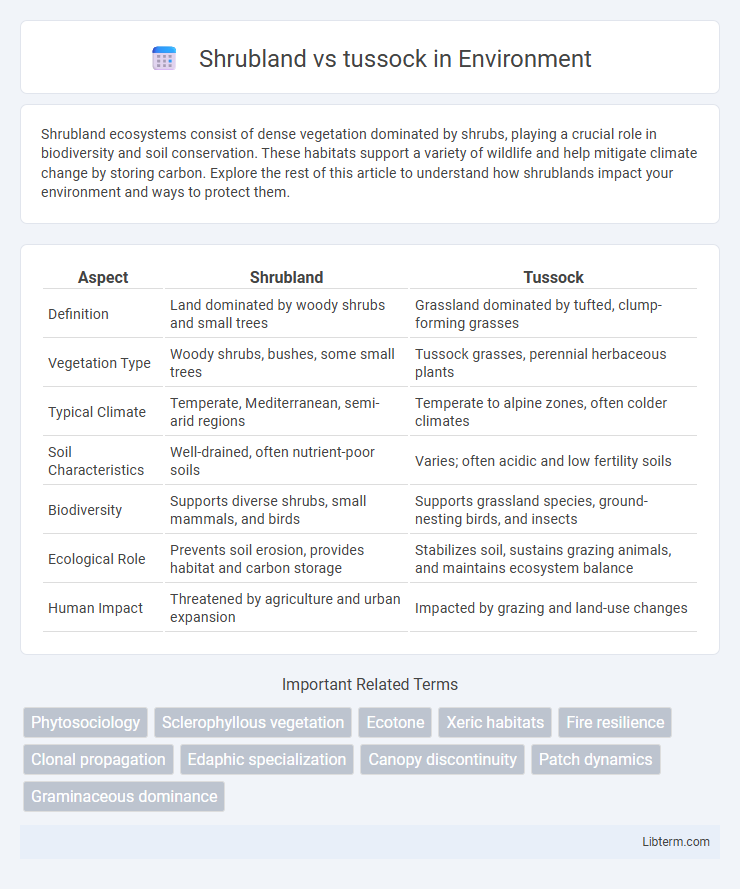Shrubland ecosystems consist of dense vegetation dominated by shrubs, playing a crucial role in biodiversity and soil conservation. These habitats support a variety of wildlife and help mitigate climate change by storing carbon. Explore the rest of this article to understand how shrublands impact your environment and ways to protect them.
Table of Comparison
| Aspect | Shrubland | Tussock |
|---|---|---|
| Definition | Land dominated by woody shrubs and small trees | Grassland dominated by tufted, clump-forming grasses |
| Vegetation Type | Woody shrubs, bushes, some small trees | Tussock grasses, perennial herbaceous plants |
| Typical Climate | Temperate, Mediterranean, semi-arid regions | Temperate to alpine zones, often colder climates |
| Soil Characteristics | Well-drained, often nutrient-poor soils | Varies; often acidic and low fertility soils |
| Biodiversity | Supports diverse shrubs, small mammals, and birds | Supports grassland species, ground-nesting birds, and insects |
| Ecological Role | Prevents soil erosion, provides habitat and carbon storage | Stabilizes soil, sustains grazing animals, and maintains ecosystem balance |
| Human Impact | Threatened by agriculture and urban expansion | Impacted by grazing and land-use changes |
Introduction to Shrubland and Tussock Ecosystems
Shrubland ecosystems are characterized by dense vegetation dominated by woody shrubs, supporting diverse wildlife and playing a crucial role in carbon sequestration and soil stabilization. Tussock ecosystems consist primarily of tufted grasses, forming clumps that provide habitat for specialized flora and fauna, aiding in water retention and erosion control. Both ecosystems contribute significantly to biodiversity and ecological balance in arid and semi-arid regions.
Key Characteristics of Shrubland
Shrubland is defined by dense, woody vegetation dominated by shrubs typically between 0.5 to 5 meters tall, forming continuous or patchy cover often adapted to dry, nutrient-poor soils. It supports diverse flora and fauna with fire-resistant species and exhibits adaptations such as deep root systems for water absorption in arid environments. Unlike tussock grasslands, shrubland's structural complexity provides critical habitat and contributes significantly to ecosystem services like carbon storage and soil stabilization.
Defining Features of Tussock Areas
Tussock areas are characterized by dense clumps of perennial grasses, typically forming hummocky surfaces with gaps of bare soil or low vegetation, distinguishing them from shrublands dominated by woody plants. These ecosystems often thrive in well-drained, nutrient-poor soils and experience periodic fire or grazing, which maintain the tussock grass structure. Tussock formations play a crucial role in soil stabilization, water retention, and providing habitat for specialized fauna adapted to open grassland conditions.
Climate and Environmental Conditions
Shrubland ecosystems thrive in semi-arid to temperate climates characterized by moderate rainfall and well-drained soils, supporting dense woody vegetation adapted to withstand drought and occasional fires. Tussock grasslands occur in cooler, often alpine or subalpine regions with higher precipitation and poorer soil fertility, favoring clumped grasses that conserve moisture and resist grazing pressures. Both habitats play crucial roles in carbon sequestration and biodiversity under distinct climate regimes, influencing their vegetation structure and ecological functions.
Native Flora in Shrublands vs Tussocks
Native flora in shrublands typically consists of dense woody plants such as manuka and kanuka, which provide critical habitat and stabilize soil. Tussocks, dominated by grass species like Chionochloa, support a different ecosystem with open, grassy landscapes that promote biodiversity distinct from shrublands. These native plant communities reflect adaptations to their specific environments, influencing soil composition, moisture retention, and wildlife presence.
Fauna Diversity and Habitat Value
Shrubland ecosystems support higher fauna diversity by providing varied vegetation layers that offer food and shelter for mammals, birds, and insects, enhancing habitat complexity and species richness. Tussock grasslands primarily support ground-dwelling species and specialized herbivores adapted to open spaces, contributing to distinctive but less structurally diverse faunal communities. The greater structural heterogeneity in shrublands generally results in increased habitat value and ecological niches compared to the more uniform tussock habitats.
Ecological Functions and Importance
Shrubland ecosystems play a crucial role in soil stabilization, carbon sequestration, and providing habitat diversity for wildlife, supporting pollinators and small mammals. Tussock grasslands contribute significantly to nutrient cycling, offer erosion control, and sustain herbivorous species that maintain grassland health and biodiversity. Both vegetation types are vital for maintaining ecosystem resilience and climate regulation in their respective biomes.
Human Impact and Land Management
Human impact on shrubland and tussock ecosystems varies significantly due to differences in land management practices and resource utilization. Intensive grazing and agricultural conversion in tussock areas often lead to soil degradation and loss of biodiversity, whereas shrublands can suffer from fire suppression and invasive species encroachment that alter native vegetation structure. Effective land management strategies such as rotational grazing, controlled burns, and restoration planting are crucial to maintain ecosystem health and prevent long-term environmental damage in both shrubland and tussock landscapes.
Conservation Challenges and Efforts
Shrubland ecosystems face conservation challenges from invasive species, habitat fragmentation, and altered fire regimes, threatening native biodiversity and ecosystem functions. Tussock grasslands are vulnerable to overgrazing, soil erosion, and climate change impacts, necessitating targeted restoration and sustainable land management practices. Conservation efforts emphasize protecting endemic species, controlling invasive plants, and promoting community-based initiatives to enhance ecosystem resilience.
Future Outlook for Shrubland and Tussock Ecosystems
Shrubland ecosystems are expected to expand as climate change and altered fire regimes promote woody plant encroachment, enhancing carbon sequestration but potentially reducing biodiversity in tussock grasslands. Tussock ecosystems face threats from invasive species and prolonged droughts, leading to habitat fragmentation and declining native grass populations. Effective land management and restoration strategies will be crucial to balance shrub encroachment while preserving tussock ecosystem services and resilience.
Shrubland Infographic

 libterm.com
libterm.com